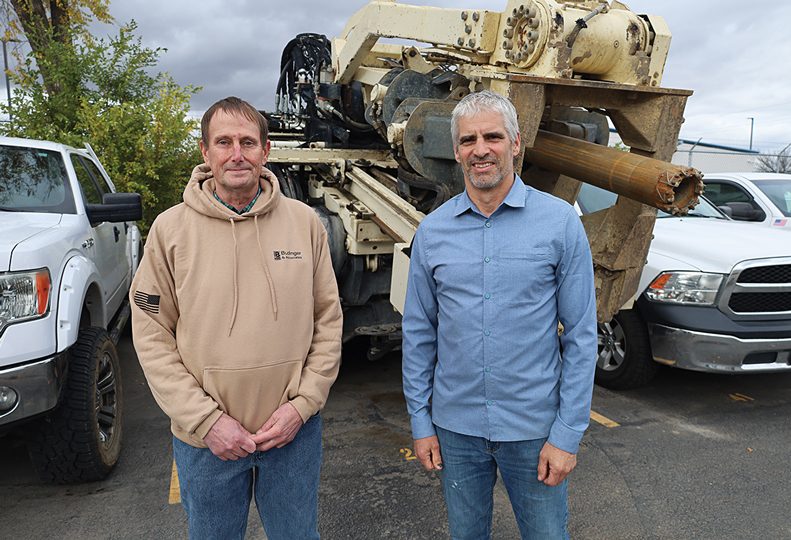
Budinger & Associates benefits from infill development
High-rise projects also are source of growth for firm

Steve Burchett, left, and John Finnegan say an increasing number of developers are turning to Budinger & Associates to evaluate the ground and soil for construction projects.
| Karina EliasAs the Inland Northwest region grows, the number of locations with good soil to build has dwindled, prompting developers to look toward more challenging sites for their projects, says John Finnegan, CEO of environmental services company Budinger & Associates Inc.
Challenging sites include those with contaminated soil and land with a loose-fill problem, two areas in which the engineers and geologists at Budinger & Associates specialize in services for remediation and construction.
“For us, as this area grows, the (ideal) sites are fewer and farther between,” says Finnegan, a geotechnical engineer and hydrogeologist. “When you start getting into other areas where the subsurface conditions aren’t as easy to work with … that drives the uptick in our work."
As a result, Finnegan says Budinger & Associates' revenue has increased 10% in each of the last four years.
Steve Burchett, president and environmental engineer, notes that there are between 20 and 30 unregulated landfills in and around Spokane, which are old community dumps where people would pitch their garbage over the edge of a hill. Now, people are looking to clean up some of those dumps and investing on their cleanup. More grant and loan programs are being offered now that help owners clean up a site to develop it, such as special low-income loan programs, like the Brownfields Program, he adds.
“Environmental assessment and cleanup have been increasingly required by lenders, and lenders have been more willing to lend money on environmentally questionable sites,” Burchett says, “Especially if the work is done through coordination or (the state's) formal Voluntary Cleanup Program, which provides assurance and review that the proposed work will be acceptable and final.”
Other unused or underused properties that require environmental remediation include old gas stations and industrial properties, digging up lead shot from the soil at gun ranges, and treating the soil to stabilize and develop over it. At a recent apartment complex construction site, construction crews began building on clean soil, but as they got closer to the center of the property, they discovered an old ash pile from when Mount St. Helens erupted in 1980. Volcanic ash isn't an issue unless it enters a body of water, Burchett says, but it does need to get cleaned up to build housing over it.
Finnegan, who along with a group of geologists and geotechnical engineers focus on determining what’s happening just below the surface of the earth, says the leading geotechnical problem characterizing the terrain of the region is loose fill. One of the leading sources of loose fill is remnants from old fires that occurred at the turn of the century, he says. When buildings burn down, they generate a tremendous amount of debris and rubble that has to go somewhere; often those remains were pushed over hillsides and into depressions, he says.
“Then that real estate eventually became more valuable and needed to be built upon,” Finnegan says. “Then folks like us have to go out there and figure out, how bad is it? And how deep is it? And what can we do to build on it?”
Budinger & Associates was established in 1976 and is headquartered at 1101 N. Fancher Road, in Spokane Valley. The 10,000-square-foot facility houses office spaces, materials and soil laboratories, and the exploration and geotechnical department. It has just over 70 employees including four licensed geologists, three licensed drillers, lab technicians, exploration technicians, and construction materials technicians, among others. Finnegan and Burchett have been with the company since 1991 and 1990, respectively.
Long-term on-call clients include the city of Spokane, Spokane County, the city of Spokane Valley, and the Spokane Transit Authority. On the industry side, clients include Spokane-based Avista Corp. and several Spokane-based construction companies. Budinger & Associates also offers its services to homeowners and works on projects like foundation cracks and water issues, Finnegan says.
Some of the projects the company has worked and consulted on include the L.B. Stone Properties Group's Falls Tower project on Spokane’s North Bank, the Sherman Tower for Hagadone Hospitality Co. in downtown Coeur d’Alene, and the Thomas George luxury high-rise condominium project taking shape in downtown Coeur d’Alene.
“It seems like in the past two years, taller buildings have been the focus (for construction),” Finnegan says. “These residential and mixed towers have been an area of growth for us.”
The ground where the long-planned Falls Tower on 600 N. Lincoln historically had been a bay of the Spokane River that had about 60 feet of loose fill, Finnegan says. To prepare the site for construction, Budinger & Associates’ crew will drill 60-foot-deep shafts and place peers on the rock at the bottom of the loose fill, as opposed to digging it out, he says.
Usually, projects that Budinger & Associates takes on last a couple of months, Finnegan says. One project that deviates from this approach is the company’s operation of the Kaiser water treatment plant located at the long-shuttered Kaiser Aluminum Corp. Mead Works facility.
The treatment plant is owned and operated by the Kaiser Mead Custodial Trust, separate from the ownership of the rest of the former facility, Burchett says. In January 2022, two years after the Dallas-based engineering company Jacobs built the plant, the trust retained Budinger & Associates to operate the plant.
“We are sampling and monitoring groundwater,” he says. “Which we did before the plant was constructed. When (Jacobs) was building it, we were doing materials testing and quality control during the construction process on behalf of the owner.”
Budinger & Associates usually has one to two people at the site every day and one person for a half-day on the weekends, he says.
While the company has grown over the years, the biggest challenge it continues to face is work source development. For example, when Spokane Community College closed its construction materials testing program about 15 years ago, it had an impact on small environmental engineering companies, city, and the state Department of Transportation, Finnegan says.
As a result, Budinger & Associates and other companies and agencies have taken on the work of training people on materials testing in-house. While the company has three licensed drillers, they and the industry could use more, he says. Most drillers working now are getting older, and the pipeline for younger drillers is small, he says.
“In the old days, you couldn’t get a job if you didn’t have that associate degree,” Finnegan says. “Now it's not offered, we have to make due.”





![Brad head shot[1] web](https://www.spokanejournal.com/ext/resources/2025/03/10/thumb/Brad-Head-Shot[1]_web.jpg?1741642753)